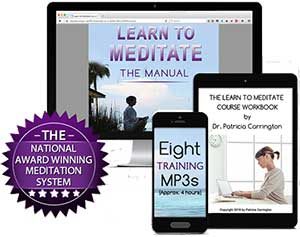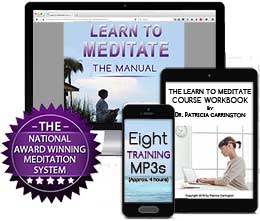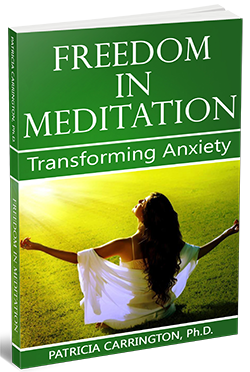 Problems in the Use of Meditation
Problems in the Use of Meditation
Blocks in meditating represent one type of problem with which many people working with meditation must deal. An entirely different difficulty arises, however, when meditation is embraced for the wrong reasons, or when it is used in an undesirable fashion, problems may be inevitable.
While some people shy away from meditation, others take it up with too much intensity. If twenty minutes twice a day is beneficial, then some people think that two or three or four hours of meditating per day should be correspondingly better . As with any therapeutic dosage, of course, this is not the case. If one pill is prescribed, taking the whole bottle is not a good idea.
While the proper amount of meditation time may be highly beneficial, anything over that amount may have adverse effects. For some people, even fifteen or twenty minutes of meditating at one time is too much. When I speak of over meditation, however, I mean a much longer amount of meditation. For the average person practicing practical meditation, this might be defined as meditating more than one hour a day for the first year, and after that for more than one hour at a single sitting, or more than two hours on the same day – keep in mind that a ‘safe’ limit may be considerably lower than this for certain individuals.
During ordinary meditation, tension-release can produce side-effects which, at times, can cause difficulty if they aren’t regulated. If meditation is prolonged for a matter of hours this process of tension-release can be magnified many times. When a person spends this much time meditating, powerful emotions and ‘primary process’ (bizarre) thoughts may be released too rapidly to assimilate, and the meditator may be forced into sudden confrontation with long buried aspects for which the person is not prepared.
If the individual has enough inner strength, or is doing the extra meditation under the supervision of an experienced teacher, the meditator may weather such an upsurge of unconscious material and emerge triumphant. If the individual has fewer inner resources or has a past history of emotional disturbance, the meditator may become overwhelmed by it, fragile defenses may break down, and an episode of mental disarray may occur.
This eventuality can be guarded against by responsible teachers of meditation who strictly limit the amount of time the meditator is advised to spend meditating. Transcendental Meditation (TM), for example, is limited to no more than two twenty-minute sessions daily, as are the general instructions in my Clinically Standardized Meditation (CSM), which allows individuals to adjust their meditation duration and frequency, while gaining benefits from the practice.
Problems from Over-Meditation
Addicted to Meditating
- When Meditation Becomes an Addiction
Those who choose to meditate against explicit instructions on how much time they should be spent meditating are often people with deep-seated personality problems who make use of meditation in a very special way. Over-meditating seems to be similar to other forms of addiction. Studies of drug usage have shown that those who tend to abuse drugs, as opposed to those who simply use them, show many more signs of personality disturbance, social withdrawal, and the like.
In the same way, those who consistently over-meditate, when studied from a psychiatric perspective, most often either have a previous history of addiction to drugs or have other psychiatric problems of a serious nature. Taken in heavy doses in a person with an unstable background, meditation can be dangerous.
When People Purposely Over-Meditate
- A Case of Underlying Emotional Issues
To my knowledge there is no such thing as a mild case of true over-meditation. When a person comes to the point of meditating many hours a day, alone and without supervision, that person usually has been experiencing a disturbed emotional adjustment or deeply troubling personality problems, prior to beginning a practice of meditating. In such situations, over-meditation can increase the individual's difficulties, and may push such a person over the brink, as it were, precipitating a serious psychiatric condition.
One instance of over-meditation occurred in a Transcendental Meditator who had been carefully instructed not to meditate more than twenty minutes twice a day. When Dudley contacted me for advice he reported a list of symptoms sufficiently distressing to cause almost anyone to panic. While physical and neurological examinations had shown that he had no identifiable diseases, he complained of dizziness, pressure in his head, physical ‘rushes’ that would ‘go to his eyes, ears, nose, and throat’, and an inability to tolerate bright lights.
More distressing to him, however, was his feeling that people seemed ‘unreal’ and only a reflection of his own consciousness. He had an intense feeling of alienation and experienced a ‘tremendous gulf’ between himself and others. He also could experience only what was in his immediate visual field; the back of a house did not ‘exist’ for him unless he walked around to the other side and actually saw it. If a person left the room where he was, that person ceased to ‘exist’ until he or she reappeared. The present felt eternal.
When he went to sleep he felt he was ‘leaving’ his body; and one night when he saw a horror movie on TV he vividly imagined, in fact was convinced, that, like the figure on the screen, he was carrying ice picks in his hand. He was terrified of what he might do with them.
The more Dudley meditated, the worse these symptoms became. When he contacted me he reported that he was regularly meditating three hours a day, plus repeating his mantra to himself throughout the day. What was particularly significant was that Dudley claimed he had not realized that he should not meditate this much. Since TM teachers and checkers repeatedly stress the proper amount of time for meditation, this young man clearly had chosen to ‘selectively in-attend’ to what they were saying. For reasons of his own, he had apparently needed to escape into an oblivion created through over-meditating.
Some of Dudley’s symptoms superficially resemble some of the experiences reported by mystics: the disappearance of time, the eternal moment, the sense of leaving the body, the reflection of one’s own consciousness in the universe, for example. When these experiences are under the control of the person having them and are intentional, they can be an important part of a person’s spiritual development. In Dudley’s case, however, no amount of guidance from meditation teachers had been able to change his chaotic experience into a constructive, positive one. He was reporting compulsive symptoms, perhaps unconsciously borrowed from the reports of spiritually inclined people, but used for his own maladaptive purposes. They were out of his control and consistently negative.
Dudley’s background emerged during the diagnostic interview. For many years numerous personality problems had prevented him from growing up emotionally. Treatment with such therapies as behavior modification and hypnosis had been to no avail. While the specific symptoms that Dudley was experiencing were apparently released by over-meditation, their basic cause seems to have been the disturbed adjustment, which he had experienced all through his life.
To cope with a growing rage, frustration, and shame, derived from a life-time of family issues and separation anxiety, Dudley began to bury himself in meditation as one might lose oneself in a drug. An intelligent man, he must have known that he should not over-meditate in that fashion, but had chosen to do so until he was literally flooded by unpleasant symptoms. When he consulted me, he had recently stopped meditating entirely (a decision which I advised him to stick to), but his symptoms continued to worsen.
Dudley is typical of those who consistently over-meditate. His symptoms seemed to stem not so much from meditation in and of itself as from the neurotic misuse of meditation. When he was challenged in a single diagnostic interview to face some of the basic issues that were underlying his problem, his symptoms temporarily became much less intense. His sense of time returned and his orientation in space and sense of reality were almost entirely reinstated by the end of two hours of conversation with the therapist.
While over-meditation seems to have paved the way for Dudley’s emotional disturbance, it cannot be said to have actually caused it, considering the ease with which, temporarily at least, his symptoms cleared up with insight.
What his case teaches is the necessity for probing deeply into the causes of excessive over-meditation. The chances are that over-meditation will be found to reflect deep emotional problems. These problems must be treated in order to effect a permanent cure for whatever symptoms arise.
Over-Meditation Requirements of Some Programs and Cults
- What You Should Know
This is an important point to bear in mind, because some of the so-called super-cults require that their followers meditate for many hours each day. At one time, the members of the International Society for Krishna Consciousness spent two to three hours chanting the ‘Hare Krishna’ when awakening in the morning and followed this by additional sessions of chanting at various points throughout the day. Other groups such as the Unification Church of Sun Myung Moon, which flourished in the 1970s, encouraged similar intensive meditation in their followers. The control of such super-cults over their followers raises a number of questions about possible exploitation of followers who have been confused and rendered highly suggestible by over-meditation.
Obviously over-meditation on a wide scale could have serious consequences. However, the practical forms of meditation which, when properly followed, are always used in moderation. While moderation is insisted upon for ordinary practitioners, teachers of some forms of practical meditation, on the other hand, may be required to meditate continually for long periods of time every day as part of their training. TM teachers, for example, are periodically required to attend residence courses where intensive regimes of meditation (up to several hours a day) are required for periods of six or more weeks at a time. Not surprisingly, an occasional TM teacher has been known to develop serious emotional problems, either during or shortly after such training, and several such cases have been called to my professional attention. In light of the heavy meditation requirement for TM teacher trainees, therefore, it would seem that a decision to become a TM teacher should be weighed just as carefully as a decision to undertake any other regime requiring extensive meditation would be.
In light of the temptation to over-meditate that is seen in certain susceptible individuals and the potential risk involved for their mental health if such a person were to do so, it is essential for anyone thinking of joining a movement that includes meditation as part of its program to inquire about the amount of time they will be asked to spend daily in this practice. Prospective meditators may also want to look carefully at other aspects of any movement they are thinking of joining to make certain their own personal liberty and freedom of thought will be preserved.
Responsible training programs offering intensive meditation should supply low pressure, non-coercive and supportive retreats where every participant is free to remain fully in command of their own life, to make their own decisions, and to come and go as they wish. To make certain of the non coercive atmosphere of any large-scale ‘spiritual’ training program may take careful investigation, since a number of the more notorious organizations have been known to recruit through ‘front’ organizations with names that are unknown and seemingly innocuous. Certainly, a preliminary investigation of any cult’s background is crucial if one’s personal safety and mental health are to be safeguarded.
Even in the most unpressured and genuinely supportive retreat, however, catastrophes sometimes arise, and the addition of an adequate clinical staff of trained mental health professionals appears essential for such programs. If professionally trained assistance does not exist in an intensive meditation-based program, the decision to enter a group requiring large amounts of meditation every day requires careful thought. Small, decentralized meditation settings, where considerable personal guidance is afforded each trainee by a highly qualified teacher, or else responsible home instruction, are usually preferable to the mass organizations.
These special precautions do not ordinarily apply to the practical forms of meditation undertaken by the average person, however. Practical meditation may add an important dimension to your life, but it does not become a way of life.
However, when a meditator is engaged in formal psychotherapy, common, practical forms of meditation seem to be the only type appropriate for use, as an adjunct to therapy.
Discover Clinically Standardized Meditation, an easy, safe, and affordable from of meditation.
The Learn to Meditate Course
Dr. Carrington’s Clinically Standardized Meditation (CSM) has been used by individuals, medical institutions, and organizations, worldwide. The main advantages of CSM (and also its difference to other meditation techniques) are its simplicity, its flexibility, and its sensitivity to the individual intentions and needs of those who learn it. CSM is extremely permissive, which makes it easier to personalize and internalize its experience.
Patricia Carrington, Ph.D.
Author of “Freedom in Meditation”







